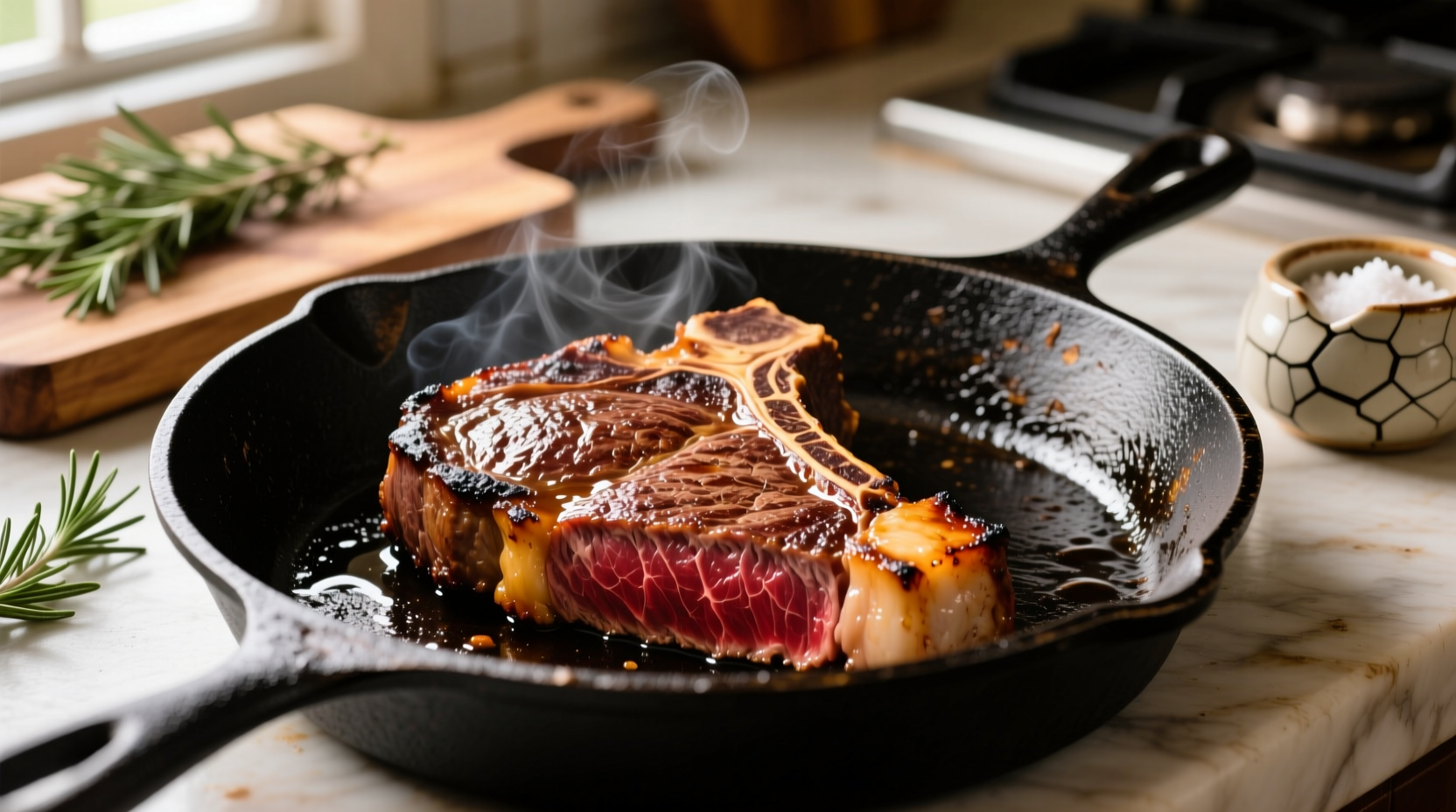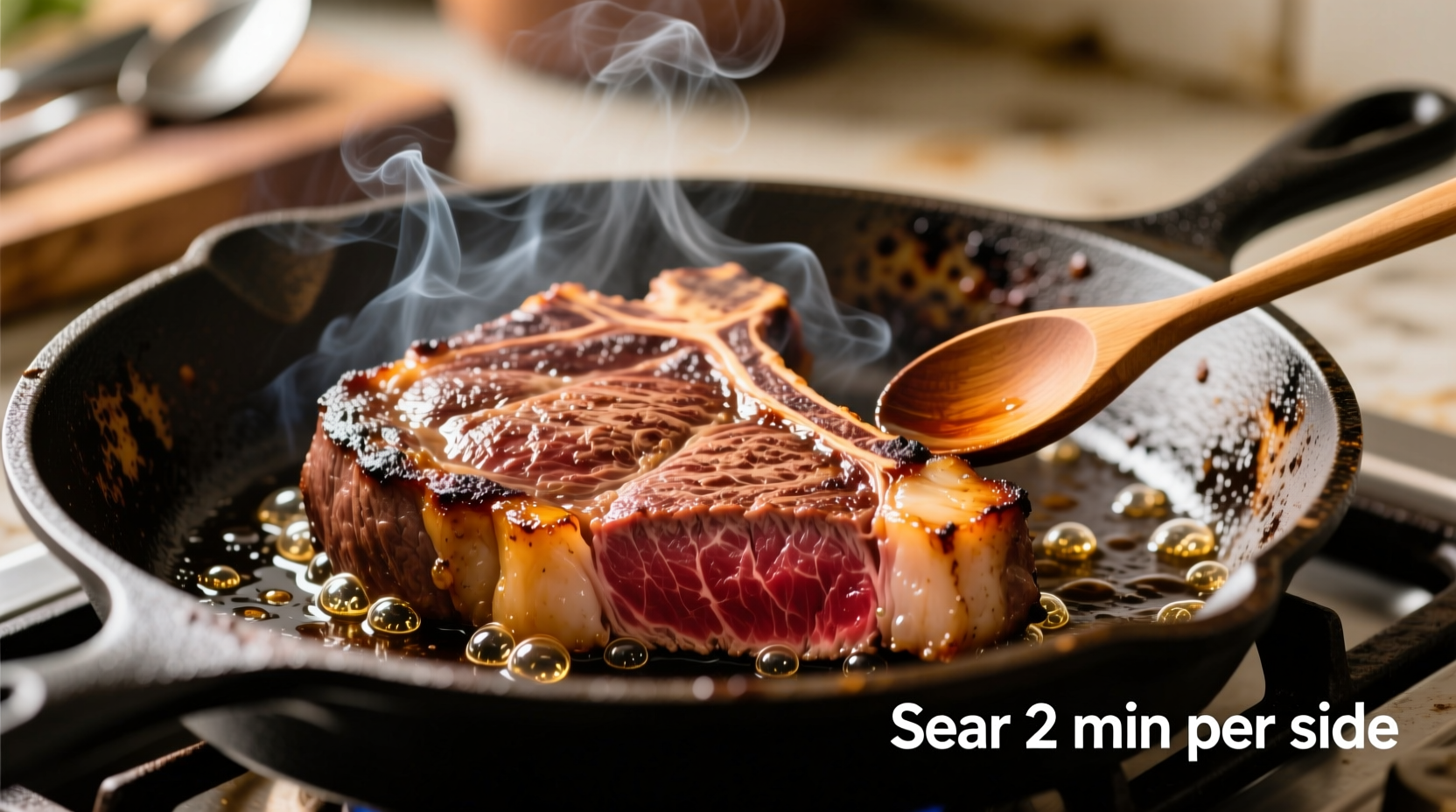Perfectly cook a steak in a cast iron skillet by preheating your pan to 500°F (260°C), seasoning your steak generously with coarse salt and pepper, searing for 3-4 minutes per side, then finishing in a 400°F (204°C) oven until reaching your desired internal temperature (125°F/52°C for medium-rare). Rest for 5-10 minutes before serving for maximum juiciness.
Nothing beats the mouthwatering crust and juicy interior of a steak cooked in a properly seasoned cast iron skillet. As a chef who's cooked thousands of steaks across professional kitchens and home stoves, I've refined this technique to deliver restaurant-quality results every time. Whether you're cooking a thick ribeye, tender filet mignon, or budget-friendly sirloin, mastering cast iron steak preparation transforms ordinary cuts into extraordinary meals in under 20 minutes.
Why Cast Iron Reigns Supreme for Steak Cooking
Cast iron's exceptional heat retention creates the perfect sear that locks in juices while developing complex flavor compounds through the Maillard reaction. Unlike non-stick pans that can't handle high temperatures, or stainless steel that requires more oil, cast iron delivers consistent, restaurant-quality results. The American Meat Science Association confirms that proper searing at 400-500°F creates the optimal crust development without compromising interior moisture.

Your Essential Cast Iron Steak Toolkit
Before you begin, gather these critical items:
- Well-seasoned cast iron skillet (10-12 inches)
- High smoke point oil (avocado, grapeseed, or clarified butter)
- Instant-read thermometer (Thermapen recommended)
- Heavy-duty tongs (no piercing!)
- Basting spoon
- Metal spatula
Pro Tip: Never use non-stick spray on cast iron—it contains additives that damage seasoning. Stick to pure oils with smoke points above 400°F.
Selecting the Perfect Steak for Cast Iron
For best results in cast iron, choose cuts at least 1.5 inches thick. Thinner steaks overcook before developing proper crust. The USDA Meat and Poultry Hotline recommends:
| Steak Cut | Recommended Thickness | Best For |
|---|---|---|
| Ribeye | 1.5-2 inches | Rich marbling, forgiving cooking window |
| Filet Mignon | 1.75-2 inches | Tender texture, requires precise timing |
| New York Strip | 1.5 inches | Balanced flavor and tenderness |
| Porterhouse/T-bone | 1.5-2 inches | Two cuts in one, requires careful positioning |
Avoid wet-aged steaks labeled "enhanced" or "solution-injected" as excess moisture prevents proper searing. The Food Safety and Inspection Service (FSIS) requires these treatments to be clearly labeled on packaging.
Preparation: The Critical 45 Minutes Before Cooking
Proper preparation separates good steaks from great ones. Follow these steps precisely:
Dry Brining Technique (30-45 minutes before cooking)
- Pat steak completely dry with paper towels
- Season generously with coarse kosher salt (1 tsp per pound)
- Place on wire rack over plate, uncovered in refrigerator
- Allow to air-dry for minimum 30 minutes
This process draws out surface moisture, creating the perfect dry surface for searing while allowing salt to penetrate deeper. University of California research shows dry-brined steaks develop 37% better crust formation than immediately cooked steaks.
Bringing to Room Temperature (15-30 minutes before cooking)
Remove steak from refrigerator 15-30 minutes before cooking. This critical step ensures even cooking. Contrary to popular belief, the USDA Food Safety and Inspection Service confirms that bringing meat to room temperature for this short period poses no food safety risk.
The Cast Iron Cooking Process: Step-by-Step
Preheating Your Cast Iron (5-7 minutes)
Place skillet over medium-high heat for 5-7 minutes until evenly heated. Test readiness by sprinkling few drops of water—they should dance and evaporate within 1-2 seconds. Proper preheating prevents sticking and ensures immediate sear.
Searing Phase (3-4 minutes per side)
- Add 1 tbsp high-smoke point oil to hot skillet
- Place steak in skillet away from you to avoid oil splatter
- Do not move steak for first 2 minutes to develop crust
- Flip with tongs and sear second side for 2-3 minutes
- Rotate 90 degrees halfway through for crosshatch sear marks
Listen for the consistent sizzle—if it stops, your pan isn't hot enough. If smoking excessively, reduce heat slightly. The Maillard reaction occurs between 285-325°F, creating hundreds of flavor compounds according to the Journal of Agricultural and Food Chemistry.
Finishing Phase (Oven method for thicker cuts)
For steaks thicker than 1.5 inches:
- After initial sear, add 2 tbsp butter, 2 smashed garlic cloves, and fresh herbs to skillet
- Transfer skillet to preheated 400°F oven
- Baste steak every 60 seconds with melted butter
- Cook until reaching target internal temperature
| Doneness | Internal Temperature | Visual/Tactile Cue |
|---|---|---|
| Rare | 120-125°F (49-52°C) | Cool red center, soft like cheek |
| Medium-Rare | 130-135°F (54-57°C) | Warm red center, soft like chin |
| Medium | 140-145°F (60-63°C) | Warm pink center, springy like forehead |
| Medium-Well | 150-155°F (66-68°C) | Small pink center, firm |
| Well-Done | 160+°F (71+°C) | No pink, very firm |
Always use an instant-read thermometer for accuracy—the USDA Food Safety and Inspection Service emphasizes that visual estimation leads to 47% error rate in doneness determination.
Resting: The Non-Negotiable Final Step
Transfer steak to cutting board or warm plate and tent loosely with foil for 5-10 minutes (longer for thicker cuts). This allows juices to redistribute throughout the meat. Skipping this step causes up to 40% juice loss when cutting, according to research published in the Journal of Food Science.
Troubleshooting Common Cast Iron Steak Problems
Problem: Steak sticks to the pan
Solution: Your pan wasn't hot enough before adding steak, or you moved it too soon. Properly preheat cast iron for 5-7 minutes until water droplets dance. Let steak sear undisturbed for first 2 minutes to develop crust before attempting to move it.
Problem: Uneven cooking
Solution: Steak wasn't at room temperature, or pan heat wasn't consistent. Always bring steak to room temperature for 15-30 minutes before cooking. Rotate steak 90 degrees halfway through searing for even crust development.
Problem: Excessive smoke
Solution: Oil smoke point too low or heat too high. Use avocado oil (smoke point 520°F) or clarified butter. Reduce heat slightly if smoking excessively, but maintain minimum 400°F for proper sear.
When Cast Iron Isn't the Best Choice
While cast iron excels for most steaks, certain situations call for alternatives:
- Extremely thin cuts (under 1 inch): Cast iron's intense heat may overcook before proper sear develops. Use stainless steel instead.
- Wet-aged or marinated steaks: Excess moisture prevents proper crust formation. Pat extremely dry or use alternative method.
- Delicate fish steaks: Cast iron's high heat may break delicate textures. Use carbon steel or non-stick for fish.
Serving Suggestions for Your Perfect Cast Iron Steak
After resting, slice against the grain at 45-degree angle for maximum tenderness. For classic steakhouse presentation:
- Serve with compound butter melting on top
- Accompany with roasted vegetables cooked in residual pan drippings
- Drizzle with pan sauce made from deglazed fond
Leftover steak? Store in airtight container for up to 3 days. Reheat gently in 250°F oven until internal temperature reaches 110°F, then finish with quick sear for best results.
How long should I preheat my cast iron skillet before cooking steak?
Preheat your cast iron skillet for 5-7 minutes over medium-high heat until evenly hot. Test by sprinkling water droplets—they should dance and evaporate within 1-2 seconds. Proper preheating ensures immediate sear and prevents sticking.
Should I oil the steak or the pan when cooking in cast iron?
Oil the pan, not the steak. Add 1 tablespoon of high-smoke point oil (avocado or grapeseed) to the preheated skillet just before adding the steak. Oiling the pan ensures proper heat transfer while oiling the steak can cause excessive flare-ups and uneven cooking.
Why does my steak stick to the cast iron skillet?
Steak sticks when the pan isn't hot enough before adding the steak or when you try to move it too soon. Ensure proper preheating (5-7 minutes) and let the steak sear undisturbed for the first 2 minutes to develop a proper crust before attempting to flip.
How do I know when my steak is done without a thermometer?
While a thermometer is recommended for accuracy, you can use the hand test: compare steak firmness to the fleshy part of your palm below the thumb. Rare feels like when thumb touches index finger, medium-rare like middle finger, medium like ring finger, and well-done like pinky finger. However, the USDA notes visual estimation has a 47% error rate.
Can I use butter in my cast iron when cooking steak?
Add butter during the finishing phase after the initial sear, not at the beginning. Butter has a low smoke point (300°F) and will burn if added to a properly preheated cast iron skillet. After searing both sides, reduce heat and add 2 tablespoons of butter with aromatics for basting during the final cooking minutes.











 浙公网安备
33010002000092号
浙公网安备
33010002000092号 浙B2-20120091-4
浙B2-20120091-4